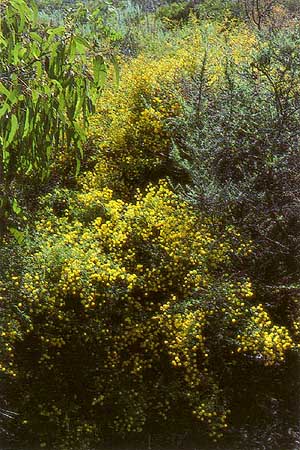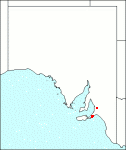Family: Fabaceae
Acacia pulchella

Derivation: pulchellus (L.)—beautiful and little.
Synonymy: Not Applicable Common name: western prickly Moses
Description:
A shrub to 1.5 m tall, branching freely; branchlets spine tipped, slightly flexuose, pale green, glabrous or with sparse, to 3 mm long, erect hairs. Spines 1-2 at each node, to 8 mm long, one often longer than the other. Stipules to 1 mm long. Petiole (common rachis) to 0.5 mm long with terminal dark brown subspinescent setae; pinna rachis about 5 mm long, flattened and with a few ciliate hairs along its margins, bearing 3-5 pinnae, pinnules 3-4 mm long, 1 mm wide, oblong, glabrous, gland solitary, stipitate, 1-1.5 mm.
Inflorescences mostly simple, solitary from each node; peduncles 10-18 mm long, glabrous; flower-heads, not seen, reported 5-8 mm diam. with 25-40 flowers. Legumes (only one seen 3 cm long) 1.5-5 cm long, 3-5 mm wide, glabrous. Seeds (not seen) reported orbicular to oblong, longitudinal. Funicle filiform swelling to an aril adjacent to the seed.
|
|
Distribution:
|
To date restricted to a single population in Deep Creek Conservation Park, but see notes below.
|
Flowering time: September.
|

SA Distribution Map based
on current data relating to
specimens held in the
State Herbarium of South Australia
|
Biology:
No text
Related taxa:
Maslin (1975) considers A. pulchella most closely related to A. lasiocarpa and A. megacephala two species in W.Aust. In South Australia only likely to be confused with A. mitchellii (sp. 113) and A. farnesiana (sp. 110). From the first it is readily separated by its spine tipped branchlets and axillary spines and from A. farnesiana by its single pair of leaflets and flat rather than swollen pods.
Taxonomic notes:
A recent study by Jasper, Abbott & Robson (1989) showed that VA mycorrhizal fungi were important in the growth and establishment of A. pulchella and that major soil disturbance, in this case by bauxite mining, reduced the infectivity. Major losses incurred after the original vegetation was cleared suggesting that mycorrhizal activity depends on the propagules remaining attached to a living plant. Under the experimental conditions Acacia growth was increased if the disturbed soil was inoculated with effective VA mycorrhizal fungi. Other references to regeneration and the effect of mycorrhizal fungi may be found in their bibliography.
Acacia pulchella has only recently been detected in South Australia and was collected at Deep Creek Conservation Park by R. Taplin in October 1989. A small colony of shrubs to 1.5 m tall had become established. Virtually nothing is known of its potential in this State. It is widespread in Western Australia.
It is native to Western Australia and occurs south-west of a line drawn from Geraldton to Esperance. Within that area it is a variable species and Maslin (1975) describes no less than six varieties. Our material agrees most closely with var. glaberrima Meisn. one of the most widely spread varieties.
Acacia pulchella is one of twenty-four species comprising the series Pulchellae all of which occur in Western Australia except A. mitchellii in Eastern Australia including a minor local occurrence near Mount Gambier in our South-East.
The common rachis of the bipinnate leaves is often so short that, superficially, the leaves look like two axillary simply pinnate leaves. It is readily separated from A. mitchellii by the spinescent ends to the branchlets and the well developed stipular spines, A. mitchellii being quite unarmed and from Acacia farnesiana which is a larger woodier shrub and has distinctly swollen legumes.
Some of the biology of A. pulchella in Western Australia was reported by Monk et al. (1981). The species was studied in the vicinity of Perth where it behaves as a 'fire weed'. Dense populations may grow following fires. Plant density was as high as 10,100 plants per ha after germination was complete after the first growing season and declined to 1,600-250 per ha in the 13th year. Intense intraspecific competition occurred in the early years often with high mortality. It was believed that 13 years was near the normal maximum life span of the species as none occurred in sites that had been fire free for 15 years or more. No flowering was seen in the first season but almost all plants flowered in the second year. Up to 12,000 seeds per plant were produced in the 3rd and 4th seasons and thereafter declined to 2,000 seeds per plant in the 13th year.
Seed accumulated in the soil at only a fraction of the extent expected from the cumulative fall of seeds indicating heavy predation or removal. Most of the seeds were in the top 3 cm of the soil and none germinated from greater than 5.5 cm. Seedlings emerged after the first winter rains. Nodulation was seen 4 weeks after germination and nitrogen fixation and accumulation was active by 3 weeks. Tables and graphs of most features of the experiments were provided.
Guinet et al. (1980) examined gross morphology, seedling and pollen morphology and seed chemistry of the series Pulchellae. The series comprise a coherent group of 21 species plus six less closely related ones, all in Western Australia except for A. mitchellii the only non western species which proved to be atypical and is better placed in section Uninervia. The relationships of the group were closest to the phyllodinous groups in series Uninerves and Continuae and distant from the Botrycephalae. The results are too detailed to give here but are supported by tables of data, illustrations and diagrams and should be referred to for details.
Cultivation:
Provides a free flowering garden-worthy shrub of small to moderate size.
Author:
Not yet available
Source:

|

